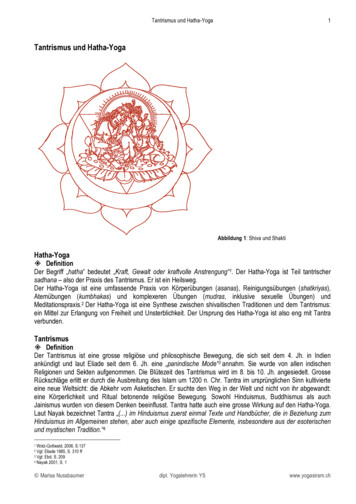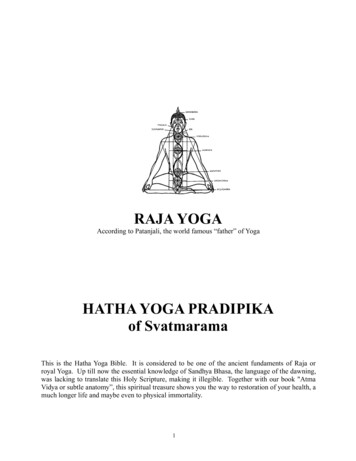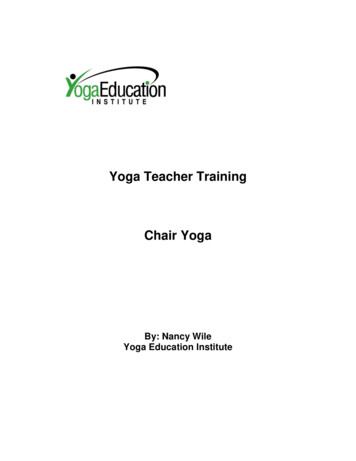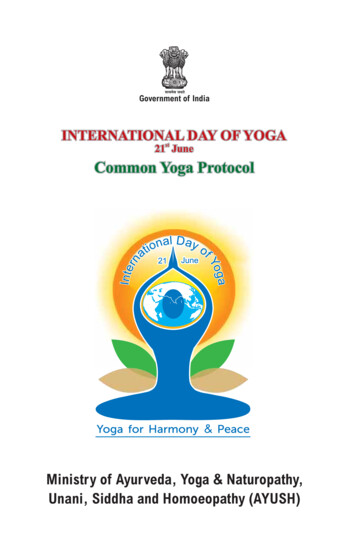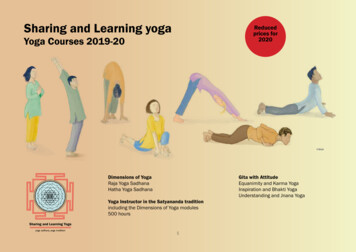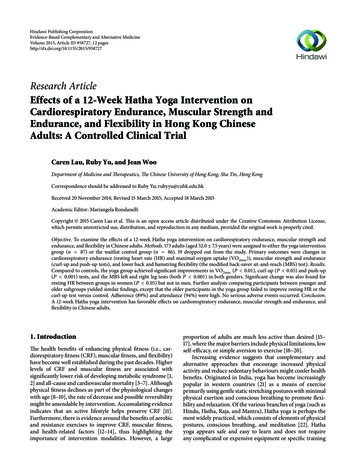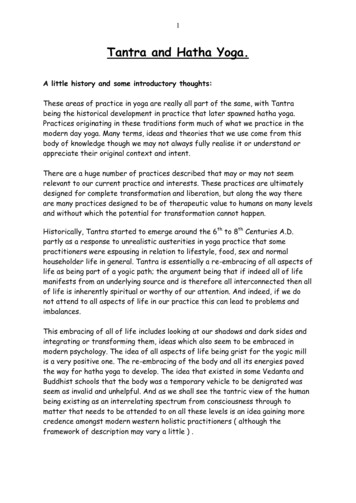
Transcription
1Tantra and Hatha Yoga.A little history and some introductory thoughts:These areas of practice in yoga are really all part of the same, with Tantrabeing the historical development in practice that later spawned hatha yoga.Practices originating in these traditions form much of what we practice in themodern day yoga. Many terms, ideas and theories that we use come from thisbody of knowledge though we may not always fully realise it or understand orappreciate their original context and intent.There are a huge number of practices described that may or may not seemrelevant to our current practice and interests. These practices are ultimatelydesigned for complete transformation and liberation, but along the way thereare many practices designed to be of therapeutic value to humans on many levelsand without which the potential for transformation cannot happen.Historically, Tantra started to emerge around the 6th to 8th Centuries A.D.partly as a response to unrealistic austerities in yoga practice that somepractitioners were espousing in relation to lifestyle, food, sex and normalhouseholder life in general. Tantra is essentially a re-embracing of all aspects oflife as being part of a yogic path; the argument being that if indeed all of lifemanifests from an underlying source and is therefore all interconnected then allof life is inherently spiritual or worthy of our attention. And indeed, if we donot attend to all aspects of life in our practice this can lead to problems andimbalances.This embracing of all of life includes looking at our shadows and dark sides andintegrating or transforming them, ideas which also seem to be embraced inmodern psychology. The idea of all aspects of life being grist for the yogic millis a very positive one. The re-embracing of the body and all its energies pavedthe way for hatha yoga to develop. The idea that existed in some Vedanta andBuddhist schools that the body was a temporary vehicle to be denigrated wasseem as invalid and unhelpful. And as we shall see the tantric view of the humanbeing existing as an interrelating spectrum from consciousness through tomatter that needs to be attended to on all these levels is an idea gaining morecredence amongst modern western holistic practitioners ( although theframework of description may vary a little ) .
2It’s an important concept in both tantra and hatha yoga that if we are torelease ourselves from restrictive conditioning , then this has to happen withinthe body and the mind on all levels and not just one bit or the other; or , to usea computer analogy, if not deleted properly, the conditioning software virus willjust reinstall itself via the unaddressed level.From this perspective the tantric philosophy is very complete. That said it’s alarge area that we’re not going to go into much more here. The main thing isthat it is the base for hatha yoga. There are different branches of it and somepretty weird practices associated with it (sitting in a graveyard on a pile of dungwith a pot of burning ashes on your head – any takers?)Much tantra presented in the west focuses on sexual practices, which while partof the original tradition, is just a small part, not the whole thing.Hatha YogaHatha Yoga is a later development of tantra (probably around the 14th century).It’s really its own thing, but with mainly the same philosophical basis as tantra.Hatha yoga encompasses asana, pranayama, meditation and includes Patanjali’stheory although presented a little differently. The older texts mostlyassociated with it are the Hatha Yoga Pradipika, the Gheranda Samhita, and theSiva Samhita – which all broadly describe the same practices and introduce theasanas as we would recognise them properly for the first time.Most of what is taught in the modern west is a derivative of hatha yoga . If wecould define it, it might be: ‘the balancing and unification of opposites to mergewith a unified consciousness’. This unification and balancing of opposites is acentral theme both philosophically and literally in terms of the practices.Traditionally Ha refers to the sun, male energy, left brain processes, rationalitysympathetic nervous system, linear time and the right side of the body; Tha tothe moon, female energy, right brain creative activity, non-linear space, intuitionand the left side of the body. The practices are orientated around balancingthese two opposite tendencies on many levels to head towards a unifiedtranscendent state.Relationship of hatha yoga to other practices in yoga.We can conceive of Yoga Practice as having 2 main frameworks, or 2 parallelways of describing the same process. These two processes are happeningsimultaneously. Viewed this way some of the more esoteric descriptions in Hatha
3Yoga and Tantra seem more obviously connected to other descriptions of yoga.1. A Mind/Psychological/philosophical model - this is the language ofgetting a perspective on, and deconstructing our conditioning so we cansee the truth of who/what we are really are below the surface activity of themind through the means of mind/body disciplines, philosophical inquiry andmeditation. This is clearly laid out in Patanjalis Yoga Sutras and the yogic pathof the Buddha. It tends to focus most on ethics, right living and meditation.2. A Body/Energy (Prana) model - this is the language of the body both in theway we would recognise it and though subtle anatomy and the energy body Koshas (gross and subtle forms of the body), Nadis, Chakras and Kundalini etc.This is the engagement of body and mind in practices, that revolve aroundremoving blockages and tensions in the energy flow in the body/mind andincreasing energetic concentrations and vibrations though directed awarenessand/or movement. These ideas are laid out in the Hatha Yoga Pradipika, andTantric texts.Both 'psychological' and 'energetic' types of practice are mentioned toone degree or another in all of the main Yoga texts as the two frameworks ofpractice run parallel to each other in their effects (Whether or not we are fullyaware of this). They are not separate as demonstrated by there beingreferences to subtle anatomy in the Upanishads, the Bhagavad-Gita andPatanjali as well as there being references to Atman, Purusha, Karma etc in theHatha Yoga Pradipika and Tantric texts.
4Main concepts, principles and dynamics of SubtleAnatomy in Tantra and the Hatha Yoga.Five Koshas ( bodies)One of the most helpful ideas in hatha yoga is that of the five koshas - The fivesheaths/bodies. Five interlinked and interrelated bodies are described (seediagram and descriptions below). Essentially the principle is that we existthough an interrelating spectrum ranging from matter to pure consciousness andthat all these layers are talking to each other all the time.This two dimensional diagram is only a conceptual map as the bodies areinteractive.1. Anna-Maya-kosha; our familiar physical body or 'food body' bywhich we navigate the material world.2. Prana-Maya-kosha; the Prana body (Prana as Life force) is the energy fieldthat is associated with, and sustains the physical body. It is the connecting linkbetween the physical body and the mind and provides the field for much oftraditional hatha yoga.
53. Mano-Maya-kosha; Lower functions of the mind - sensory input anddesire, doubt and confusion. Vacillating according to the predominatingGunas in this field, Rajas (activity and stimulation) and Tamas (inertia).4. Vijnana-maya-kosha; Higher functions of the mind - discernment andwisdom. Tends towards clarity and lucidity due to due to the predominating gunain this field - Sattva.5. Ananda-Maya-kosha; the bliss body associated with the correctidentification with Atman or pure conciousness.All the bodies support each other. As well as hatha yoga, many traditional Asianhealthcare practices have similar conceptions of the human being and willconsider health and wellbeing as a holistic picture. We seem to be getting therein the west also .Prana - usually translates as 'Life Force', 'that which animates','psycho-energy' or vitality due to its close relationship to the mind. It isreferred to in the Far East as Chi or Ki. It is considered to be closely related tothe breath (though it is not actually the breath) and can be influenced throughbreathing practices (Pranayama). There is no clear definition of prana and Ihave struggled over the concept and it’s sometimes English counterpart ‘energy’. My best sense is that it is referring to the holistic picture of our anatomy,physiology and mind in interrelationship; and ‘blockages’ on any of these levelswill somehow show up in our energetic sense of ourselves and how we feel .Hatha yoga certainly looks at the idea of ‘blockages’ , whether literallyphysically, or mentally/emotionally and how to release them . Sometimeselectrical systems, circuits and batteries type analogies are used to describeprana. (Interesting that we also use terms such as 'I need to recharge mybatteries' in colloquial language, to describe our experience of energy levels orlack of). Also bear in mind that there are a number of other words also denotingprana such as Shakti, prakriti ( to some extent) , kundalini . Also within ourhuman system we have subdivisions of prana moving in different directions (Desikachar’s Heart of Yoga chapters on breathing and pranayama describesthese accessibly)For Pranayama we can reflect on the fact that the breath is the first and lastanimation of the body and the seemingly close relationship between the breathand differing states of mind.
6There are also considered to be 5 subdivisions of Prana all performingdifferent functions in the body. (See Desikachar, ‘Heart of Yoga’ chap 6 forsome details) . Gregor Maehle’s book on Pranayama goes through traditionalpranayama in depth.Nadisare a similar idea as Meridians/Sen lines and other Eastern terminology forenergy pathways in the body: described in two main ways - either as minutetubes distributing prana or as currents of prana along certain pathways. Eitherway no subtle anatomy of this nature has yet really been verified empirically,only experientially or by inference. Various outlandish figures are given invarious texts as to the number of Nadis in the body with 72,000 being a popularfigure which seems to just be a figure for ‘a lot’ .In most people many of the nadis are considered to be blocked or to have veryweak currents and Hatha Yoga in part is about releasing blocks and stimulatingthe flow of Prana in Nadis and Chakras through Mind/Body practices for generalhealth, personality integration, and ultimately spiritual transformation. Somemodern practitioners are speculating whether fascia may relate to the energybody as it is all pervading through the body, though this is as yet unknown.In Thai medical theory which has a relationship to hatha yoga they have a wordcalled ‘sen’ which translates as a ‘connecting pathway of movement’ . They alsosay they are 72,000 of these (same story I suspect). BUT the Thai descriptionof sen is that these movement pathways exist on a spectrum from gross tosubtle including : some muscle and fascial lines, tendons, ligament, arteries,veins, blood vessels, nerves and then moving to more ‘invisible sen’ such asneurotransmitters , movements of mind and so forth . Thai massage is alsoconcerned with ‘blocks’ in the sen on all levels. This I find somewhat easier thanthe Indian description .Below - 72,000 Nadis!
7The Three Main Nadis and the seven Chakras.The 3 main nadis that we are concerned with are Ida Nadi, Pingala Nadi andShushumna Nadi which all start around the perineum. The Shushumna nadi isthe central channel roughly equating to the centre of the spinal cord with IdaNadi running up the left side passing via the left nostril and Pingala Nadi running
8up the right side passing via the right nostril. Sometimes they are illustrated asspiralling around Shushumna, crossing at each chakra rather than running upeach side. (Some authors place the channels and chakras as in front of thespine).Pingala Nadi - accessed by the right nostril in Pranayama - corresponds to solarenergy, the sympathetic nervous system, the left side of the brain (rational),the right side of the body, linear time, masculine principles, the guna Rajas, andthe Ha of Hatha Yoga.Ida Nadi - accessed by the left nostril - corresponds to Lunar energy, theparasympathetic nervous system, the right side of the brain (creative), the leftside of the body, non-linear space, feminine principles, the guna Tamas, and theTha of Hatha Yoga.Ida and Pingala Nadi join and end at the 6th Chakra.Shushumna Nadi is the central channel corresponding to perfect balance andunification of opposites ( Hatha Yoga ) and the guna Sattva. The ShushumnaNadi pierces through all the 7 chakras which will only be properly activated totheir full potential when Prana moves into the shushumna via the base of thespine which is blocked to varying degrees in most people. It possibly relates towhat is sometimes referred to as the ‘invisible spine’ which is the internal spacefrom the perineum to the fontanel which can sensed with grounding, movementand breath in the asanas.ChakrasSeven chakras are depicted in hatha yoga. They have speculative parallels insome branches of evolutionary biology and theories of human developmentincluding as they do all our tendencies from our reptilian natures – mammaliannatures – competitive natures – loving, empathic, accepting natures – intellectualnatures – intuitive natures – though to pure consciousness. As mentioned withinin tantra – the idea is that we embrace and integrate all aspects of our natureinto practice. Anything left unacknowledged will probably pop up in someproblematic form (!) . They are activated though asanas, pranayamas,visualisation , meditation and mantras. ( and life of course) .They go from the base (perineum) to the fontanel (crown) and are depicted inlotus flower form. A google image search will reveal lots of visuals.
9The chakras with their generally agreed characteristics ( though not anexhaustive description) :1. Muladhara chakra.Located at the base of the spine around the perineum. Earth element.Mantra - Lam. Reptilian nature. Relates to being Earth bound and restricted, butin the positive sense being grounded (think of the interrelationship between thefeet, the pelvis, mulabhandha and the sacrum). It is the base support forthe other Chakras and serves as the resting place for Kundalini Shakti(essentially the potential for Prana to rise up). It is from here that prana canrise up Sushumna nadi when ida and pingala are balanced through asanas,pranayama and/or meditation.2. Svadishthana chakraLocated at the genitals. Water element. Mammalian nature. Mantra - Vam.Relates to the sexual urge, desire in general and the potentially afflictiveemotions oflust, anger, greed, delusion, pride and envy; it also influences ourbasic approach to life in terms of being tactful and diplomatic or not.3. Manipura ChakraLocated at solar plexus. Fire Element. Competitive assertive nature. Mantra Ram. Relates to digestion, and our effectiveness in the world on the materiallevel - our confidence to 'get out there' and do what we need to do. In westernterms sometimes referred to as the '2nd brain' due to the highly complex nerveplexus in the area.4. Anahata ChakraLocated at the heart. Element of air. Our empathic, loving, accepting andcommunicative nature Mantra - Yam. Primarily relating to non attatchment,calmness, kindness and compassion . Generally considered to be the mostimportant chakra as it balances any negative effects or excesses of the lowerand higher Chakras and coordinates harmonious development. Excesses in thelower chakras cause problems if the heart is not balanced, and likewise a lack ofbalance with the higher Chakras can cause psychic hypersensitivity and mentalimbalance (For Example some psychiatric patients can display lower and higherchakra imbalances in exaggerated forms). The heart rather than the head is
10considered to be the bridge between consciousness and the body. Also relatesto the 'inner sound' or Nada, OM. It is interesting that in some Asian languagesthere is a word translating as 'heart/mind', a non-separation of the two.5. Vishuddha ChakraLocated at the throat. Element ether. Intellectual nature. Mantra - Ham. Oftenreferred to as the communication centre (in the sense of speech) but moreaccurately related to balances such as inhale/exhale, speech/silence,fluctuations in metabolism (consider the thyroid gland) and our ability to study.6. Ajna Chakra3rd eye in the middle of the forehead. Mantra - Om. Intuitive nature. Themeeting place of Ida, Pingala and Shushumna. Considered to be the psychiccentre which can serve the other Chakras well.7. Sahasrara ChakraA Seemingly luminous structure relating to infinity and identificationwith pure conciousness when activated. Mantra - Om. At enlightenment theconsciousness can leave the body to merge with absolute.)All aspects of human life are represented. Higher chakras are not better thanlower chakras. The issues that arise are one area is overdeveloped and anotherunderdeveloped or not developed .Possible links of Chakras to the endocrine system and nerve plexus havebeen suggested – physiologically the endocrine system and nervous system areinterrelated and constantly changing and both influence, and respond to, ourinteractions with the world - as in theory Chakras do; but these comparisons aretentative and impossible to substantiate at this point. Traditionally in Yoga thisrelationship is denied (as Western Watering down) and it is often categoricallystated that this subtle energy system exists and we need to refine ourawareness (and open our minds) to attune in to it. ( I definitely don’t know ) .Some people claim that we do experience Chakras as part of daily life andour colloquial language reflects it by the use of terms such as'butterflies in the stomach', 'choked', 'gutted', ‘heart broken’ and 'blownaway'. We also might describe some people (or daily newspapers even) as
11operating on a base level (!)Granthis and BhandhasGranthis are considered to be areas of blockage in the nadi/chakra system andBhandhas are the tool by which they are unblocked.1. Brahma Granthi - situated at the base of the system (and spine) andmuladhara chakra and is pierced by Mulabhandha (or Root 'lock'). On one levelBrahma Granthi reputedly prevents proper personality development (we couldspeculate about these in relation to the need to be properly grounded on theearth in order for our personality to have its full expression.) On a morespiritual plane its' unblocking also reputedly breaks attachment to possessions,body and material objects.2. Vishnu Granthi – situated around the heart area ( front mid thoracic spinearea) is pierced by Uddiyana Bhandha (Translates as flying up). On one levelVishnu Granthi reputedly relates to the unwillingness to let go of ego andpersonal power in order to embrace connectedness with others and compassion.(Interesting to consider what has to go in order for the other to happen). Onanother level, perhaps paradoxically, its release also breaks attachment topeople - relatives and friends (we could speculate whether this relates tounhealthily conditioned relationship dynamics)3. Rudra Granthi – situated between the heart and 3rd eye (cervical spine andthroat region) is pierced by Jalandra Bhandha (Traditionally chin lock thoughperhaps also a continuation of the upward movement from Uddiyana Bhandha).On one level Rudra Granthi reputedly relates to a fear of losing touch withothers when merging with the absolute. (Would this be true or would we relateto them in a more healthy way?). On another level its unblocking breaksattachments to psychic visions and powers. (Maybe we don't have this problemyet?)Maha Bhandha - all of the bhandhas used together. We mightconsider that in good movement in Hatha Yoga this is what happens anyway.There is a particular pose (Something like a more upright Janu Sirsasana) thatis traditionally used for this purpose.It seems that there is a distinction between bhandhas and their moresubtle arising in relation to good Asana practice ( pelvic floor, diaphragm, good
12head position and breath) and their use in a more forceful wayseemingly sometimes prescribed in some traditional sources.The use of bandhas in asana is really to support the release and lengthening ofthe spine in movement . When they are used in Pranayama it is more to sealconcentrations of prana in the torso by blocking off the escape routes of pranaeither down through the pelvic floor ( mulabandha) or up into the cranium (Jalandrabandha in its form as more a chin lock) .Traditionally the Bandhas relate mainly to the unblocking of thegranthis. But interestingly, on the physical level the bandhas seem to supportand help open main stress points on the spine in terms of movement restrictionand compression. Bandhas also play a different role in Pranayama ( see later)Mudras - are an additional practice relating to prana and the mind - basicallythey are symbolic hand positions which have certain energetic effects inconcentrating Prana or sealing energetic circuits. They also influence certainmind states.Mantras – the use of chanting and sound to influence areas of the body on avibratory level.Energetics, Dynamics and interactions of Hatha Yoga andTantra within Prana-Maya Kosha.There are 3 or 4 slightly varying explanations all essentially pointing to thesame outcome when Hatha Yoga is practiced successfully - that of therising of Prana up the sushumna nadi which wakes up and animatesthe Chakras in turn leading eventually to a unified consciousness experience ofBrahman, Purusha etc.It is considered that prana normally flows in Ida and Pingala nadi (Haand Tha, right and left channels) or predominates on one or the other (like theway the breath changes nostrils throughout the day) according to what mode ofmind we’re in. For example for thinking analytical work prana would dominate inthe right channel, to feed a baby – the left.Directed hatha yoga practices stimulate and balance energy flows in thesechannels so that prana can enter the Shushumna at its base; this is why theprocess is called Hatha Yoga or the uniting of opposite forces, tendencies and
13aspects to come to a balanced unitive consciousness.The descriptions and conceptions in various books can vary slightly. Basically itis conceived that prana rises up the spine when the base of the spine (thebottom of the shushumna nadi) is unblocked. The blockage is symbolised by acoiled serpent (Kundalini) - or at least this is the view taken by the Desikacharlineage. Other descriptions can give the impression there is a blockage whichwhen removed allows the Kundalini the symbolic snake to rise up shushumna (rather than it being the cause of the blockage with the blockage beingpresumably some kind of stagnation) ; but in both cases the basic idea is thesame.If we think back to Patanjali for a moment to the ideas of Prakriti ( energeticform of matter or prana in this context) and Purusha (pure consciousness) . Inhatha yoga they also talk about these in this way – Prakriti as Shakti (orkundalini Shakti sometimes) a female dynamic energy and purusha as Shiva amale pure consciousness. It is Shakti that rises up the Shushumna nadi andmeets with Shiva at the Ajna ( forehead) chakra. Shiva ( consciousness) remainsdormant as a spiritual force until stimulated by Shakti (dynamic energy). Shivaand Shakti then symbolically dance together and full integration andenlightenment is possible when the unified forces go from Ajna Chakra up toSahasara Chakra. In this way Shiva, the male transcendent consciousnessprinciple remains asleep until stimulated by Shakti, the dynamic feminineprinciple. In the same way the Shakti dynamic feminine principle, whilstenergetic, lacks vision on its own. (As the dynamic principle ‘Shakti Electronics’is a popular name for electrical shops in India!)In modern practice, during movement within Asana, correct rooting andbreathing leads to a sense of a widening lift of the pelvic floor, a secure sacrumwith the breath and the diaphragms creating a sense of a tube like space along alengthening spine; it requires a high level of mental attention and directednessto find this. This space around the spine is sometimes is often described as theinvisible spine, the sense of which exists right through from the tail to thefontanel. Whether we would want to conceive of what we are doing in the sameterms as traditional hatha yoga is another matter – but it is certainly hathayoga where the ideas and principles come from.Practices and ideas to think about in relation to HathaYoga practice.Yamas and Niyamas
14are generally considered a prerequisite for any effective Yoga practice andgiven that many blockages on the energetic level are conceived asmental/emotional/mood related, undoubtedly practicing Yama and Niyama willhave a positive energetic effect.KarmaIt is also traditionally conceived that our Karma (patterns/conditioning) isstored within the kosha (the five bodies system) and unresolvedkarma/conditioning has some kind of restricting effect on our existence onthese levels. There is an interesting concept in Thai massage theory aboutcondensation and dissipation through a five bodies type theory which statesthat mental/emotional/spiritual disharmony if not resolved and let go of willmanifest in the physical body as tension/block/disease in some form. Somethings need a physical response – asanas/massage and others a mental one –meditation/talking – most likely both is helpful.Vegetarianism and Sattvic livingis traditionally seen as necessary to purify the physical body of toxins (bothliterally from bad food and lifestyle but also negative emotions) to make it a fitvehicle for transformation. Some schools suggest vegetarianism is onlynecessary at the higher levels of practice - it is a grey area. Some suggest thatin eating animals we also take in the fear and experiences embedded in theirtissues ? Some suggest that at some point in spiritual practice the question willarise as to whether it is necessary to take other life to sustain your own whenthat may not be necessary? In the west this is probably a personal matter todecide yourself what you can live with, and perhaps through trial and error withdifferent diets. Historically there has always been a debate aboutvegetarianism in India, it is nothing new. In the hatha yoga pradipika the viewgiven is more that meat and alcohol and similar are too tamasic and toxic for thebody and mind – rather than any ethical objection to these things as such.Asanas - The Asanas given in the hatha yoga pradipika are the precursor ofwhat we do now, though only a limited range of asanas are given - presumablywhat was considered most important; it seems other aspects of the physicaltradition developed in sophistication and variation over time. Asanas form animportant part of the purification process. On various levels Asana practice canhelp as part of the clearing and healing of conditioning, blockages and tensionstored in the various systems and layers of the body; this is particularly
15possible to observe in our muscular and nervous systems aside from esotericconsiderations. Clearly part of the role of Asana is to work with, and wherepossible, through, our limitations, resistances, blockages and habitual patternsboth physical and mental. The theory of the 5 Koshas is that we have to purifythe physical body of conditioning and make space in it as a foundation forpranayama and meditation ( though it is suggested that we start with pranayamastraight away to in simple ways) .Potential dangers within Asana practice are the possibility of anunhealthy attachment to the body on an external level - making it an egoaggrandising practice where we become primarily obsessed with the body. It issuggested that whilst it is important that we start with the body and work withit, that we also include other practices.Headstand and ShoulderstandHatha yoga is the only practice that does this ridiculous thing! Why?Traditionally they are described as a support for meditation and particularlypratyahara ( balancing the senses – or becoming independent from externalstimuli) . Also another idea is that the moon exists in our head around AjnaChakra where it drips a 'nectar of life' called amrita which is burned up by theSun situated in Manipura Chakra ( our solar plexus). Headstand (Sirsasana) andShoulderstand (Sharvangasana) supposedly potentially reverse this flow thusalso preserving and lengthening life. These positions are generally lauded aspreserving youth and are certainly refreshing on various levels, but as forlengthening life .?Pranayama - energy (Prana) awareness, management and expansion.Whilst a properly conscious Asana practice can have significant effect onhow we feel energetically when the body is opened up, Pranayama, as wellas forming a mind-settling bridge to meditation, has a whole disciplineattached to it relating to fine-tuning of Prana flows. When we develop amore refined awareness of our inner environment and are less distracted bymuscular tensions and external stimuli, there is the possibility ofbecoming more attuned to the sense of vitality or life force circulatingthe body. There are many creative practices of Pranayama to balance prana flowand to potentially stimulate concentrations of prana in certain areas. Clearlythere are also effects and adjustments on our more gross physiology that wecan observe. Interestingly one of the principles in hatha yoga is that we caninfluence prana through mental attention on areas – this can potentially increase
16concentrations of prana. Certainly we can say that any practice carried out withattention and conscious awareness is more powerful than the same thing withoutattention.To briefly describe a couple of practices:Nadi sodhana (Al
Hatha Yoga Hatha Yoga is a later development of tantra (probably around the 14th century). It's really its own thing, but with mainly the same philosophical basis as tantra. Hatha yoga encompasses asana, pranayama, meditation and includes Patanjali's theory although presented a little differently. The older texts mostly
